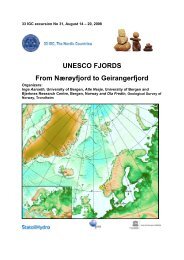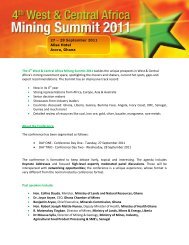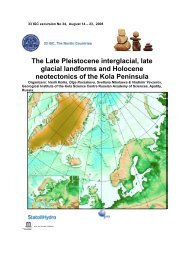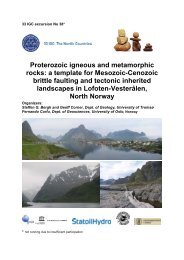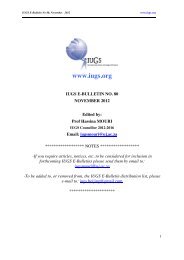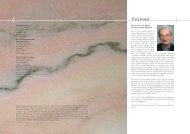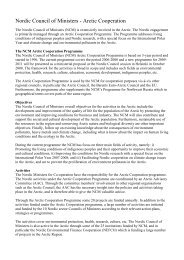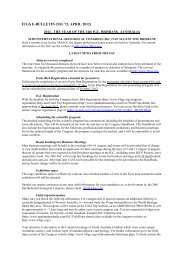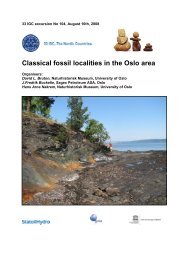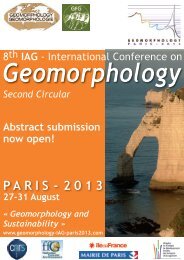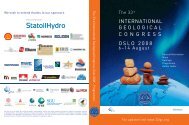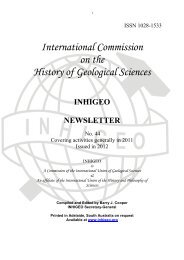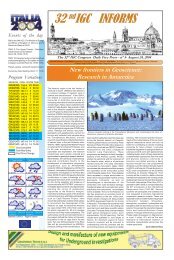The Second International Geological Congress, Bologna, 1881 - IUGS
The Second International Geological Congress, Bologna, 1881 - IUGS
The Second International Geological Congress, Bologna, 1881 - IUGS
You also want an ePaper? Increase the reach of your titles
YUMPU automatically turns print PDFs into web optimized ePapers that Google loves.
20<br />
of which 48 were geological maps, and 20,000 samples of rocks, fossils,<br />
and minerals. Most of the latter came from the collections of the<br />
Capellini Museum, but 574 rock samples and 42 large fossiliferous<br />
thin-sections came from the USA (J. Hall), 300 from Russia, 114<br />
special preparations of nummulites from Hungary (Hantken), and<br />
900 ophiolite samples, with 750 large, and 1800 small, thin sections<br />
from the Corpo delle Miniere. <strong>The</strong> most impressive publications on<br />
display were volumes 1 (1847), 2 (1852), and 5 (1879) of James<br />
Hall’s Palaeontology of New York, which were donated to Capellini.<br />
A few hundred small-scale<br />
geological maps and crosssections<br />
covering much of<br />
the countries attending the<br />
<strong>Congress</strong> were also on display.<br />
A small Guide de<br />
l’Exposition was prepared by<br />
Canavari and Mattirolo<br />
(<strong>1881</strong>) (Figure 13).<br />
<strong>The</strong> success of the ‘Geoexpo’<br />
was so great that mem-<br />
bers expressed the solemn<br />
desire for similar exhibitions<br />
always to be part of IGCs<br />
(Anonymous, 1882, p.<br />
201–10).<br />
Conclusions<br />
Figure 13 Additional publications<br />
available to the <strong>Bologna</strong> <strong>Congress</strong><br />
members (Capellini Museum).<br />
Substantial results were obtained at the 2nd IGC in <strong>Bologna</strong>, <strong>1881</strong>,<br />
and the main lines of future <strong>Congress</strong>es were established. <strong>The</strong> main<br />
accomplishments of the <strong>Bologna</strong> <strong>Congress</strong> were (1) to assemble<br />
together official institutions, research and teaching centres, academies,<br />
and distinguished scientists from all countries active in the<br />
pursuit of geology, and to contact all of them well in advance with a<br />
view to preparing a commonly agreed-upon agenda; (2) to succeed<br />
in securing agreement for the adoption of common terminology and<br />
procedures; (3) to set up a network of national disciplinary institutions<br />
reporting to internationally accepted, non-governmental, thematic<br />
commissions anchored to the flexible, rotating authority of the<br />
<strong>Congress</strong>; (4) to enable nations, groups, and individuals to use the<br />
<strong>Congress</strong> as a global show-case for advancements in whatever<br />
aspects of geology they might choose, for stimulating exchanges,<br />
training, and competition (mainly through the ‘Geoexpo’), and for<br />
settling by agreement scientific questions of relevance to the language<br />
and procedures of the science.<br />
From time to time, as happened in Paris and <strong>Bologna</strong>, it is<br />
claimed that pure scientific or academic discussions should find<br />
more space in the program of the IGCs, although this was not the<br />
principal reason for the IGC being founded. It should be stressed,<br />
however, that such issues turned out to be effectively addressed only<br />
if instrumental to the preparation of agreements on specific points of<br />
the congress agenda. Excellent up-to-date reviews and major syntheses<br />
were in fact presented at the <strong>Bologna</strong> <strong>Congress</strong> and others followed<br />
in subsequent IGCs on topics of general interest as, for example,<br />
stratigraphic correlations, chronometric dating, principles and<br />
criteria for classifying rocks and subdividing the geologic time.<br />
Although a careful and thoroughly historical evaluation of the<br />
IGCs is still to come, as a matter of fact the IGCs never played a<br />
major role in stimulating new ideas or findings in their more than a<br />
century of history. Unlike Ellenberger (1978, p. 24), this fact should<br />
not be viewed as a problem, rather as an opportunity for aiming at<br />
different achievements. Instead, IGCs have succeeded in making<br />
visible and workable the effects of new ideas and techniques.<br />
Thus, the IGC starting with the <strong>Bologna</strong> <strong>Congress</strong> was a body<br />
manifesting the cultural entity represented by the dispersed geological<br />
community and enabling geology to obtain its autonomy and<br />
identity as a science through a common language, long before a permanent<br />
trans-national institution, the <strong>IUGS</strong>, was founded.<br />
<strong>The</strong> IGC developed a special structure in view of its unique<br />
function of maintaining and improving the cultural identity of the<br />
geological sciences and their advancement. Thus, the IGC should<br />
not compete with the common scientific, specialized, thematic, and<br />
disciplinary congresses. Instead, it should favour the integration of<br />
their results and prevent the fragmentation and dispersal as a product<br />
of the overspecialization. Such a role, although not very easy to<br />
update continuously, is perhaps the reason for its long survival and<br />
increasing importance, role, and visibility.<br />
Acknowledgement<br />
Critical reviews by Glen Caldwell, William Cavazza and by an editorial<br />
referee are gratefully recognized.<br />
References<br />
Anonymous, 1880, Congrès <strong>International</strong> de Géologie: Comptes Rendus<br />
Comité Congrès Conferences, 21, Paris, 1878, Paris, Imprimerie<br />
Nationale, 313 pp.<br />
Anonymous, 1882, Congrès Géologique <strong>International</strong>: Compte Rendu 2me<br />
Session, Bologne, <strong>1881</strong>, Bologne, Fava et Garagnani, 663 pp.<br />
Capellini, G., 1882a, Historique du Congrès, in Congrès Géologique <strong>International</strong>,<br />
Compte Rendu de la 2me Session, Bologne, <strong>1881</strong>, Bologne, Imp.<br />
Fava et Garagnani, pp. 3-54.<br />
Capellini, G., 1882b, Résolutions concernant la nomenclature et les couleurs,<br />
votées par le Congrès, in Congrès Géologique <strong>International</strong>, Compte<br />
Rendu de la 2me Session, Bologne, <strong>1881</strong>, Bologne, Imp. Fava et Garagnani,<br />
pp. 196-198.<br />
Capellini, G., 1914, Ricordi: <strong>Bologna</strong>, Zanichelli, vol. 1, 242 pp.; vol. 2, 356<br />
pp.<br />
Delaire, A. and Fontannes, F., 1882, Travaux du Congrès, in Congrès<br />
Géologique <strong>International</strong>, Compte Rendu de la 2me Session, Bologne,<br />
<strong>1881</strong>, Bologne, Imp. Fava et Garagnani, pp. 57-195.<br />
Ellenberger, F., 1978, <strong>The</strong> First <strong>International</strong> <strong>Geological</strong> <strong>Congress</strong> Paris,<br />
1878: Episodes, v. 1978, no. 2, pp. 20-24.<br />
Mendenhall, T. C., 1877, Report of General Secretary: Proceedings American<br />
Association Advancement of Science, twenty-fifth meeting, Buffalo,<br />
N.Y.,August 1876, 1876-v., 25, pp. 345-360.<br />
Renevier, E., <strong>1881</strong>, Rapport sur l’unification des procédés graphiques en<br />
géologie, in Rapports des Commissions internationales pour l’unification<br />
de la nomenclature et des figurés géologiques et pour la question des<br />
règles à suivre pour établir la nomenclature des espèces, Bologne, Imp.<br />
Fava et Garagnani, pp.77-113.<br />
Vai, G.B., 2002, Giovanni Capellini and the origin of the <strong>International</strong> <strong>Geological</strong><br />
<strong>Congress</strong>: Episodes, v. 25, 248-254.<br />
Vai, G.B., and Cavazza, W. (eds), 2003, Four centuries of the word Geology:<br />
Ulisse Aldrovandi 1603 in <strong>Bologna</strong>, <strong>Bologna</strong>, Minerva Ed., 352 pp.<br />
Prof. Gian Battista Vai teaches<br />
Stratigraphic Geology at the Department<br />
of Earth and <strong>Geological</strong>-Environmental<br />
Sciences, University of<br />
<strong>Bologna</strong>. His research focuses on<br />
Mediterranean Palaeozoic, Messinian<br />
evaporites, and the history of<br />
geology. He has been a member of<br />
the ICS Silurian/Devonian Boundary<br />
Committee, Silurian and Devonian<br />
subcommissions, and is currently a<br />
member of the Neogene and Quaternary<br />
subcommissions. He was member<br />
and Vice Chairman of the IGCP<br />
Board (1980–1986). He served as<br />
head of the Italian delegation of the<br />
30th and 31st IGCs in Beijing and<br />
Rio de Janeiro respectively, and is<br />
President of the Italian National<br />
Committee of the <strong>IUGS</strong>.<br />
March 2004



